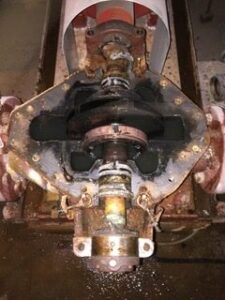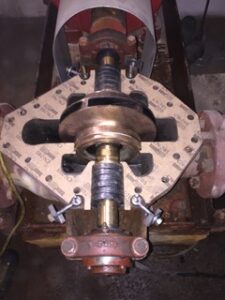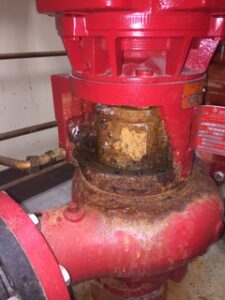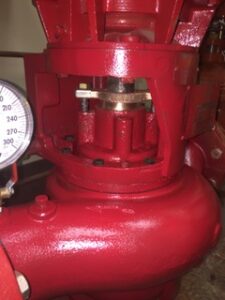How Long Should A Fire Pump Last?
August 18, 2020As a fire pump distributor, we have a unique perspective on the useful life of a fire pump. We commission and test brand new equipment, and are frequently called in to replace and repair older pumps. We are often asked about when the best time should be to replace a given fire pump, or how long should a fire pump last. So, these questions brought to life the idea to write about fire pump life expectancies. For the purposes of this article, we will focus on the fire pump itself, and not the motors, controllers, engines, or other items that are often in a mechanical room.
Fire Pump Performance
So, when should a fire pump be replaced? If an owner of a fire pump is testing and maintaining the equipment based on NFPA 25, then the answer to this question is often based on the hydraulic performance of the pump in question. The pump is tested, and perhaps it failed a flow test. For example, if the pump is rated 1000 gpm @ 100 psi boost, and upon evaluation of the performance test results the pump is now only providing 1000 gpm @ 93 psi boost, then the fire pump might need to be replaced based on this performance deficiency alone.
Over time the performance of a fire pump can degrade, due to gradual wearing of the internal casing or impeller. Another factor might be the age or appearance of the fire pump, or both. Is there still a reliable source for parts available? Is the condition of the pump such that there is a high risk of damaging the pump just by opening it for maintenance? If the answer to the former question is ‘no’, and the latter question is ‘yes’, then it might be time to replace your fire pump.
Consult a Sprinkler Contractor
It should be stated here that if you are considering the replacement of an older fire pump, you should consult a sprinkler contractor to evaluate your entire sprinkler system to make sure that a new pump of the same size is still meeting current code requirements. You do not want to invest in new equipment, only to find out that the sprinkler demand of the building has changed since the “old pump” was originally installed.
But fire pumps are mostly just sitting idle, and not operating at all (unless, of course, there is a fire). So that makes many people have a false sense of confidence that the pump will last forever. After all, most listed pumps are made of cast iron, steel, and bronze. That should last quite a while, right? The answer, in general, is yes, but there are many factors in play. What Impacts the Life of a Fire Pump?
Several factors determine the estimated operational life of a fire pump. Some of them are:
1. The type of fire pump
2. The quality of water being used
3. The environment of a mechanical room where it is installed
4. How the pump is installed
5. How the pump is tested and maintained
The type of pump will have a very large effect. Put simply, some fire pump types are built to last much longer than others. By “type”, we are referring to whether the pump is a horizontal split-case design, or close coupled end suction (or vertical inline) design.
Horizontal Split-Case Fire Pump
A horizontal split-case pump, for example, is built to be very durable and long-lasting. The impeller is hydraulically and dynamically balanced, and there are two sets of bearings to help keep thrust forces and vibration in check. The impellers are designed to allow for water to enter the impeller from both sides, which, if piped per NFPA 20 guidelines, will allow for minimal vibration. A motor or engine used with a horizontal split-case pump design will need a coupling or driveshaft to connect to the pump, which helps to simplify the design. Horizontal split-case pumps built by most manufacturers, if installed correctly and properly maintained, should last between 25 and 40 years.
This of course does not mean you will get a 25-year warranty! The reason? There are too many other factors involved that are outside the manufacturer’s control.
Vertical Inline Fire Pump
Vertical inline fire pumps, however, have a relatively lower total life expectancy. These pumps utilize a motor shaft instead of a pump shaft, and have a motor bolted directly on the pump casing. The impeller is designed to take water from one side of the casing. They are built this way to save money and are mostly used for water flows between 50 gpm and 750 gpm.
Under ideal conditions, the life expectancy of this type of fire pump design is typically between 7 and 15 years.
Water Quality
The quality of water will also have an effect. Without getting into a chemistry discussion, the cleaner the water, the better the life expectancy of the fire pump. This especially is the case when a fire pump is taking water from a chlorinated supply, such as a swimming pool. Even if the impeller material was made of a resistant bronze alloy, the chlorine in the water would eventually make its way to the air in the room, and accelerate the corrosion of any steel components. But even “clean” water, if let to sit for extended periods of time, can develop microorganisms that can gradually eat away at the internals of a pump.
Beware of Damp Environments
The pump room environment will have a very large effect on the life of a fire pump. As a general rule, the moister the air, the more components will deteriorate. The major difference here is that the external surfaces are now affected, versus the internal components. Electronic control equipment might have heaters or thermostats to keep moisture under control, but the pump is completely exposed. Over time, exposure to a damp environment will rust the cast iron and steel components of the fire pump.
Importance of Proper Fire Pump Installation
How the pump is installed can be a factor as well. NFPA 20 provides guidelines for proper installation of a fire pump — particularly horizontal split-case fire pumps. With this type of pump, it is best to have a smooth and straight run of suction to the pump, so that the water can enter the impeller with as much balanced, laminar flow as possible. Not only does this help the pump perform better, but it eliminates unnecessary stress on the pump shaft and bearings. If a suction elbow with a centerline plane parallel to the pump shaft (or, in simpler terms, a horizontal elbow feeding a horizontal pump) supplies a fire pump, you are decreasing the life expectancy of the pump rotating elements. The larger the volume of water expected to be pumped, the more problematic improper suction piping will be to the expected useful life of the fire pump.
Fire Pump Maintenance
What about ongoing maintenance of a fire pump? Is the fire pump just sitting in a dark room, with no one operating it? NFPA 25 has very specific standards not only regarding the frequency and type of pump operation, but a list of maintenance that should be done to keep the pump (and driver, and controls) in peak operating condition. The more regimented of a maintenance program that is practiced with a fire pump, the longer useful life of the fire pump equipment can be expected.
In the case of a horizontal split-case fire pump, some of the simplest maintenance procedures end up being the most important over the life of the pump. Adjusting the packing is probably top of the list. It is easy to do — adjust the packing gland bolts to maintain approximately 1 drop per second on both sides of the stuffing box (check with each manufacturer for specific guidelines). This will keep the packing moist and pliable and will minimize wear on the pump shaft sleeve. Similarly, checking the bearing lubrication can add extensive life to the bearings. Changing out bearings can be a labor-intensive endeavor, but keeping the bearings from too little (or too much) grease, can delay the need to replace the bearings significantly. Again, check with the manufacturer’s instructions for the proper procedure, and make sure a qualified and experienced technician is performing the work.



